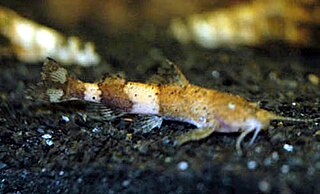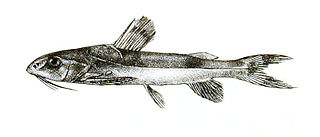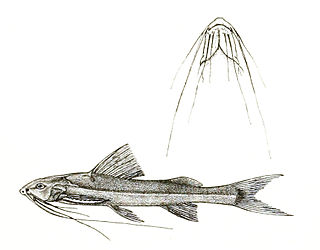
Erethistidae are a family of catfishes that originate from southern Asia. It includes about 45 species.

Pseudolaguvia is a genus of South Asian river catfishes. These species inhabit hill streams and large rivers. P. tenebricosa is found in fast running, clear water; the river has a sandy bottom and numerous rocks and boulders and aquatic vegetation is absent. P. inornata is from clear, shallow, moderately flowing streams with a predominantly sandy bottom. P. muricata is found in clear, shallow, slow-flowing streams with a mixed substrate of sand and detritus; these fish are found amongst detritus in areas with current. P. ferula is also found in swift flowing waters with a mixed rocky/sandy bottom.

Oreoglanis is a genus of fish in the family Sisoridae native to Asia. These fish live in fast-flowing streams in China, mainland Southeast Asia and the Indian subcontinent. They are mainly distributed in the Mekong, upper Salween and Irrawaddy River drainages. They range from the Brahmaputra basin to the Lam River drainage in central Vietnam. They are easily distinguished from other catfishes by their strongly depressed head and body and greatly enlarged paired fins that have been modified to form an adhesive apparatus. The flattened shape of these fish and the large pectoral and pelvic fins provide essential adhesion in the fast-flowing waters they live in.

Glyptothorax is a genus of catfishes order Siluriformes of the family Sisoridae. It is the most species-rich and widely distributed genus in the family with new species being discovered on a regular basis. These species are distributed in the Black Sea basin, northern Turkey, south and east to the Yangtze River drainage in China and south throughout Indo-China to Java, Indonesia. They are found in Asia Minor and southwards to Southeast Asia. The genus is very diverse in the Indian subcontinent. Southeast Asian species tend to have restricted distributions.
Myersglanis is a genus of sisorid catfishes native to Asia.

Batasio is a genus of catfish of the family Bagridae. These small fish are found in fast-flowing hillstreams throughout South and mainland Southeast Asia.
Ayarnangra estuarius is a species of catfish of the family Erethistidae. It is the only member of the monotypic genus Ayarnangra.
Parachiloglanis hodgarti, the torrent catfish, is a species of catfish of the family Sisoridae.
Erethistoides is a genus of South Asian river catfishes.

Erethistes is a genus of South Asian river catfishes.

Pseudecheneis is a genus of sisorid catfishes native to Asia.

Bagarius is an Asian genus of catfishes of the family Sisoridae. It includes five to six extant species and potentially one extinct fossil species, B. gigas.
Exostoma is a genus of sisorid catfishes native to Asia. These species are distributed in the Brahmaputra drainage of north-eastern India, and east and south to the Salween drainages in Burma. E. berdmorei is found in the Sittang and Salween drainages in Burma. E. labiatum is known from the Brahmaputra drainage in north-eastern India, but has also been recorded in the Salween drainage in Burma, the Ayeyarwady drainage in China, and the Brahmaputra drainage in Tibet and Burma. E. stuarti is from the Ayeyarwady River of Burma and India; however, it has not been collected since its original discovery. E. labiatum is found in mountain rapids.

Glyptosternon is a genus of sisorid catfishes native to Asia.

Gogangra is a genus of sisorid catfishes native to Asia.

Gagata is a genus of sisorid catfishes native to Asia.

Nangra is a genus of sisorid catfishes native to Asia.
Exostoma sawmteai is a species of sisorid catfish in the family Sisoridae. It is found in the Pharsih River, which is a tributary of the Tuivai River in the Barak River drainage in Mizoram, north-eastern India.
Exostoma barakense is a species of sisorid catfish in the family Sisoridae. It is found in India.
Oreoglanis majuscula is a species of catfish in the family Sisoridae, found in the Kameng River in Arunachal Pradesh state, Brahmaputra drainage, India.












